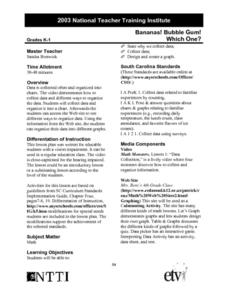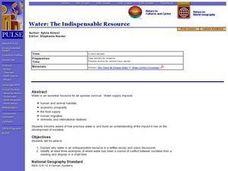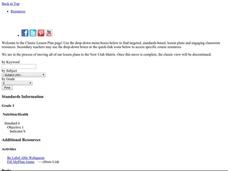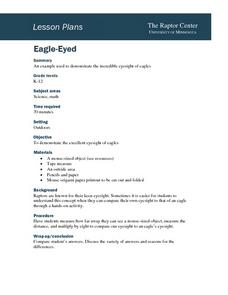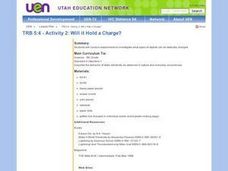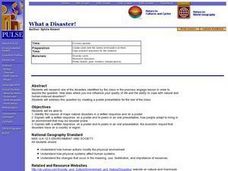Curated OER
Bananas! Bubble Gum! Which One?
Students design and create a graph of data they have collected on their favorite candy bars. They explore how to organize data as well.
Curated OER
Trade Gives Us Access to Things We Wouldn't Otherwise Have
Students work together in groups to research an item related to trade. They decide on an item that they use and determine where it comes from. They track the sources and consumers on a map.
Curated OER
Gaining Familiarity With Haitian Creole
Students investigate the concept of Haitian Creole. They first fill out a worksheet asking for prior knowledge. Then students compare and contrast the languages of English, French, and Haitian Creole. They define Creole and discuss its...
Curated OER
Planning a Trip to the North Carolina Art Museum
Students navigate the North Carolina Art Museum website and find answers to questions needed before a visit.
Curated OER
World Geography: Water: The Indispensable Resource
High schoolers are able to explain why water is an indispensable resource in a written essay and class discussion. They identify at least three examples of where water has been a source of conflict between societies from a reading and...
Curated OER
Grocery Store Problem Solving
Fourth graders explore healthy eating habits by viewing instructional videos in class. In this food pyramid lesson plan, 4th graders identify the different classifications within the food pyramid and identify how they can improve overall...
Curated OER
Grocery Store Problem Solving
Third graders practice mathematical problem solving skills. In this problem solving lesson, 3rd graders develop mathematical problem solving skills using real-world examples.
Curated OER
Eagle-Eyed
Students study the eyesight of eagles. They discuss raptors and their eyesight and compare it to their own. They measure how far away they can see a small object and its distance. They calculate the eyesight to measure an eagle's...
Curated OER
World Geography: Who am I?
Students are able to provide a basic description of one country that has arsenic in its water supply. They are able to locate these countries on a map. Students explore the majors countries that have been affected by arsenic...
Curated OER
Static Cling
Fifth graders examine the principles of static electricity and positive and negative charges. They observe and then perform experiments with static electricity. They record examples in their journals.
Curated OER
Will it Hold A Charge?
Fifth graders discuss which materials they believe hold an electric charge. In groups, they experiment with different objects and charging them. They discuss their results after the activity.
Curated OER
Circuit City
Fifth graders are introduced to the concept of circuits and how electricity works. In groups, they design their own subdivision with houses in which they have inside and outside light sources. To end the instructional activity, they...
Curated OER
What a Disaster!
Students identify the causes of major natural disasters in a written response and on a poster. They explain with a written response, on a poster and to peers in an oral presentation, how people adapt to living in an environment that may...
Curated OER
The Interactive Periodic Table of the Elements
Students study the different types of metals. In this investigative lesson students watch a demonstration on the effects of temperature on atoms and take a tour through baone matter.
Other
Podcasting 101 for K 12 Librarians
This article gets down to the basics, including what podcasts are, how to access them, how to create them, and why to use them. While it is specifically directed toward school librarians, the information is equally applicable for...


